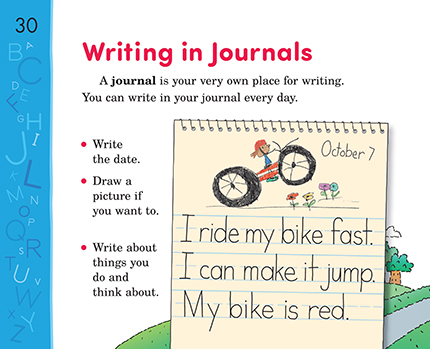Page 30 from

Start-Up Activity
Read pages 30–31. Then explain how you will use journals in your classroom. Consider these features:
- What the students’ journals should look like
- How often they will write in them
- What topics they should write about
- What you expect in terms of length
- How you will evaluate them*
Consider making journal writing a part of your regular classroom routine. For example, you could have students write entries every other day. Then on alternate days, they could exchange entries and/or share some of them with the class. But before students write their first entry, be sure to model journal writing for them. (Point out that their journal writing does not have to be perfect.)
*We recommend that students receive a performance/effort score for journal writing. (A sincere effort earns a high score.)
Enrichment Activity: With student input, generate (and display) a list of topics for journal writing. Also suggest that students write about the same topic for multiple entries if they have a lot to say about it.
Special Note: Journal writing helps student develop their writing fluency. Though ability levels may vary greatly at the start of the school year, most students have some knowledge of letter sounds and are able to approximate words. Expressing ideas freely is far more important than accurate spelling and punctuation.
Think About It
“Keep a diary. It’s a place to write things that happen, but also the kinds of feelings you are having.”
—Jean Fritz

Start-Up Activity
Read pages 30–31. Then explain how you will use journals in your classroom. Consider these features:
- What the students’ journals should look like
- How often they will write in them
- What topics they should write about
- What you expect in terms of length
- How you will evaluate them*
Consider making journal writing a part of your regular classroom routine. For example, you could have students write entries every other day. Then on alternate days, they could exchange entries and/or share some of them with the class. But before students write their first entry, be sure to model journal writing for them. (Point out that their journal writing does not have to be perfect.)
*We recommend that students receive a performance/effort score for journal writing. (A sincere effort earns a high score.)
Enrichment Activity: With student input, generate (and display) a list of topics for journal writing. Also suggest that students write about the same topic for multiple entries if they have a lot to say about it.
Special Note: Journal writing helps student develop their writing fluency. Though ability levels may vary greatly at the start of the school year, most students have some knowledge of letter sounds and are able to approximate words. Expressing ideas freely is far more important than accurate spelling and punctuation.
Think About It
“Keep a diary. It’s a place to write things that happen, but also the kinds of feelings you are having.”
—Jean Fritz